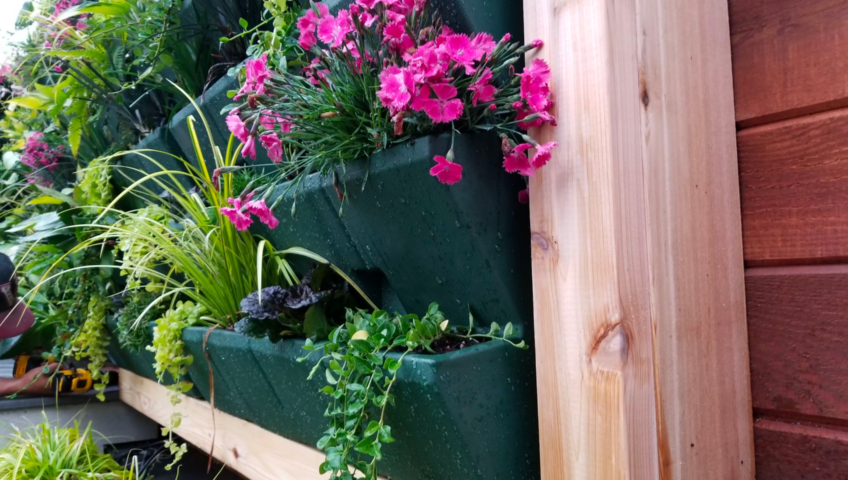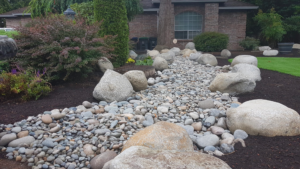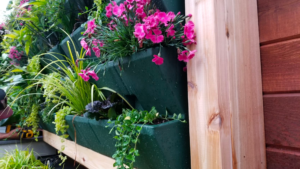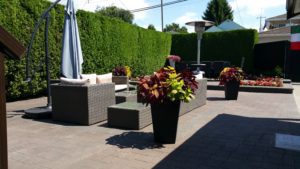Ever found yourself bewitched by a neighbor’s perfectly manicured lawn, their gravel pathway artistically paired with charming garden furniture, or perhaps the grandeur of a stone retaining wall holding back a hillside of lush greenery? If you’ve wished for such an enchanting outdoor space but got lost in navigating the sea of landscaping materials required to create such marvels – your wish just came true! Welcome to ‘Landscaping Materials 101: A Guide to Common Materials and Their Uses’, where we unravel the mystery behind all those mesmerizing landscapes! Let’s delve into this treasure trove and turn your dream into a reality!
Common landscaping materials include soil, mulch, lights, fencing, retaining wall blocks and edgers, gravel, pavers and bricks, sand, plantations, and water features. Soil is used in planting beds and repairing gardens or slopes. Mulch is used to prevent weed growth and transfer nutrients to the soil. Lights enhance the look of the landscape and make it appealing even in the dark. Fencing provides privacy and security, while also adding a decorative touch to your yard. Gravel is strong enough to support heavy vehicles and tools. Pavers and bricks provide a flexible alternative to concrete for creating patios or driveways. The sand keeps the stonework level and prevents movement. Plantations create greenery and floral sections which enhance air quality and offer a friendly feeling. Water features add aesthetic appeal while also cooling down the surroundings during summer.
Essential Landscaping Materials
When it comes to creating a beautiful and functional outdoor space, choosing the right materials is essential. There are a variety of landscaping materials available, each with its own unique benefits and uses. In this section, we will cover some of the most essential landscaping materials that should be included in any outdoor project.
One important material for any landscaping project is soil. Soil is the foundation of any garden, and choosing the right type is crucial for the health and growth of plants. Some common types of soil include sandy, loamy, and clay soils. Sandy soil typically drains well but may not hold onto nutrients as well as other types. Loamy soil is a good all-purpose soil that retains moisture but also has good drainage. Clay soil tends to retain water and may require additional amendments to improve drainage.
Another essential material for any landscape project is mulch. Mulch helps retain moisture in the soil, which can reduce the need for watering while also suppressing weed growth. Additionally, as the mulch breaks down over time, it adds organic matter to the soil which can help improve fertility.
Think of mulch as insulation for your garden beds. Just like insulation helps regulate the temperature in your home by keeping heat inside during winter months and cool air in during summer months, mulch helps regulate moisture levels in your garden beds throughout the year.
Now that we’ve covered some essential landscaping materials let’s take a closer look at the different types of soil and their benefits.
Soil Types and Their Benefits
Soil is one of the most important factors to consider when planning any outdoor project. Different plants have different needs when it comes to soil type and pH levels, so it’s essential to understand what type of soil you have before beginning any planting or amending. Here are some common types of soil and their benefits:
Sandy Soil: Sandy soil is made up of larger particles than other types of soil, which means it drains water quickly. This can be both a benefit and a drawback depending on the plant’s needs. Some plants prefer sandy soil as it allows for good drainage to prevent root rot, while others need more moisture-retentive soil. Additionally, sandy soil may not hold onto nutrients as well as other types.
Loamy Soil: Loamy soil is often considered the ideal type of soil as it combines the benefits of both sandy and clay soils. It retains moisture well but also has good drainage capabilities, meaning it won’t become waterlogged easily. Loamy soil is rich in organic matter and minerals, making it an excellent choice for planting a wide variety of plants.
Clay Soil: Clay soils are often associated with poor drainage and heavy, hard-to-work soil, but they do have some benefits. For one, clay soils tend to retain moisture well, which can be helpful in dry climates. Additionally, clay soils are often nutrient-rich and can support healthy plant growth with proper amendments. However, if drainage is an issue it may be best to amend the soil or choose plants that thrive in these conditions.
Understanding the different types of soils available and their benefits is essential when planning any landscaping project. Whether you’re choosing plants or amending existing soil, taking the time to choose the right type can lead to healthier plants and a more beautiful outdoor space overall.
Plants and Flora for Aesthetic Appeal
When embarking on a new landscaping project, it’s important to consider the aesthetic value of plants and flora. The right combination of greenery, flowers, shrubs, and trees can add texture, color, and life to any outdoor space.
One great example is using ornamental grasses in your landscape design. They come in a variety of sizes, shapes, and colors that create a textured and contrasting look. They are also low-maintenance, drought-tolerant, and deer-resistant.
Another popular option is using native plants in your garden design. Native plants are adapted to the local climate and soil, which means they require less water and maintenance than exotic species. Plus, they attract pollinators like bees and butterflies, making your garden not only beautiful but beneficial for the environment.
Adding flowering plants is sure to brighten up any landscape design. Annuals will bloom abundantly all season long while perennials offer bursts of color year after year. Mixing and matching different flower varieties can add depth, contrast, and fragrance to your backyard oasis.
In one of our recent landscaping projects, we used a combination of blue fescue grasses with purple coneflower plants. The result was stunning! We got a lot of compliments from the homeowners as well as their visitors.
Adding enough plant diversity to your landscape has fantastic benefits beyond aesthetics. With enough plant varieties, you’ll be able to attract various beneficial insects like bees who will pollinate your crops – or butterflies who will help fill your summer garden with their vibrant colored wings flitting around.
While having greenery in your outdoor space improves aesthetics and environmental benefits altogether – more isn’t always better when it comes to planting diverse species. Often times too many differing plants can make things appear cluttered or unwieldy. Choosing specific types of flora that complement the existing landscape feels more cohesive and easy on the eye.
Adding greenery and flora to your landscaping project is like painting with a brush. It adds depth and character to your canvas outside; just as adding different colors and textures creates contrast in an artwork. Failing to add greenery can cause your outdoor space to appear bare, uninviting, and lifeless; similarly producing a monochromatic artwork can make it look nameless or unremarkable.
With an understanding of the importance of adding the right plant varieties to your landscape design, let’s shift our focus to hardscaping essentials.
Hardscaping Essentials
Hardscaping elements are key components of any outdoor living area or garden design. They are the permanent structures that anchor your backyard oasis, provide boundaries, and offer functionality. Here are some hardscaping essentials worth considering:
We recently used large flagstones as pavers for a customer’s garden path. The result was both rustic and classy thanks to the material chosen. The homeowners commented how their visitors often complimented them on how well-structured their tropical garden had become since adding all-new hardscapes.
Stone pavers come in various types from durable sandstone, clay bricks, or classic concrete slabs which makes them incredibly versatile. This material’s range affords customers with many options allowing for unique designs that complement specific home styles. Furthermore, product durability due to robust materials ensures high resilience with low maintenance needs.
However, some homeowners might opt for less durable materials to cut costs such as wooden decks instead of stone patios or stepping stones instead of concrete pavers but this may result in cracks and rot if left unsealed and unprotected.
Using sturdy hardscape materials like flagstones is akin to a rock climber’s sturdy and reliable climbing gear that provides relief and safety for the journey ahead. Choosing high-quality stones, bricks or wood gives homeowners a lot of benefits that exceed simple enjoyment and style. Durability being a vital component makes sure the decision on which option to pick is not merely based on aesthetics but also function.
Hardscaping elements are crucial components of any landscaping project worth their weight in gold.
Rocks, Bricks & Wood Options
Hardscaping elements such as rocks, bricks, and wood can add texture, depth, and a touch of personality to your outdoor space. Each material brings its own unique characteristics and will give different effects to your landscape design.
When it comes to rocks, there are many options including river rock, flagstone, boulders, lava rock, and more. River rock is a great option for creating a natural-looking stream bed or dry river creek because it mimics the look of water-smoothed stones. Flagstones are flat thin pieces of stone that can be used for patios or walkways. They come in various shapes and sizes which allow for versatility when laying them down.
Boulders are large stones that bring a dramatic effect to gardens or landscapes. These stones work well in naturalistic gardens and xeriscapes where minimal maintenance is preferred. Lava rock is lightweight volcanic rock commonly used in tropical settings because of its red and black color.
Bricks have been used in landscaping for centuries because they make an excellent barrier due to their durability against extreme weather conditions. Their popularity also stems from their versatility since they come in many different colors and patterns that you can use to create unique designs. Brick is great for edging flower beds or creating pathways along your landscape using herringbone or basketweave patterns.
Wooden landscaping materials like poles, posts, or planks bring an earthy feel to any outdoor space. They blend in perfectly with surroundings characterized by trees and plants which give an overall feeling of warmth and coziness. Used as rounded logs, stakes or poles can convert a stigmatized spot into a peaceful retreat while maintaining aesthetic beauty.
For instance, if you’re designing a rustic-themed backyard featuring a fire pit area with seating around it, wood would be an excellent complement to the look. You could use wooden poles to create structural support or wooden seats where family and friends can gather around.
Constructing a retaining wall is also an ideal application for wooden planks. Not only are wood planks durable, but they will retain and add an organic layer to your landscaping structure. Once implemented with plantings at the top and bottom of the wall, it gives the appearance of a natural wood wall designed to blend well within its surroundings.
One thing to consider when using wood in your landscape design is that it is prone to rotting and termites infestations which causes an increased possibility of replacing damaged portions periodically. If water accumulation occurs below ground-level borders, this too accelerates decay.
Moving on from hardscaping essentials let’s now discuss boundaries and pathways.
Boundaries and Pathways
Fencing Materials & Paver Choices
Boundaries help define outdoor spaces in landscapes. Fences provide privacy, and security while adding curb appeal to homes. Different materials like wood, vinyl, composite, or metal can be used for fencing purposes. Wood fencing has always been popular among homeowners because of its traditional and organic feel, but people are now more aware that a more contemporary look may be achieved by using metal frames instead of wooden fences.
Vinyl fencing offers multiple designs reminiscent of traditional wood fencing, without the invasive maintenance tasks needed for upkeep as with their wooden counterparts. Its UV-resistant material composition requires no painting unless desired – a welcome benefit over time if repair costs were taken into account.
Composite fencing consists of recycled components so it’s ecologically friendly yet very uncommon in residential properties. It has incredibly high resistance against harsh weather conditions compared to metal or vinyl materials since it doesn’t rust or crack.
When constructing outdoor pathways paving stones is one way that you can add elegance and charm to your outdoor surroundings. These types of materials are perfect for areas in your yard like the patio, walkway, or around the pool where you’re looking for an upscale appearance.
Bricks, natural stones, concrete, and pavers are popular choices for pathways as they can be arranged in a variety of patterns such as herringbone, basketweave, or running bond styles. Natural patterns made by the stone’s unique features inject warmth and prosperity into garden walkways.
You can incorporate decorative patterns to blend with the surrounding greenery providing visually stunning patios or walkways. For instance, using different colored bricks in alternating checkerboard arrangements on a patio creates a display that’s colorful but not gaudy. The combination of colors adds softness and depth to the area.
Concrete pavers are preferred because of their durability, versatility, low maintenance, and availability in various textures & colors. Their flexibility makes them ideal applications for patios, walkways, driveways or even retaining walls. These pavers provide an elegant look using minimal maintenance tasks without compromising functionality.
A factor to take into account while selecting paves is the surface texture- smooth pavers are slippery when wet which increases the danger of falls, especially near water features or pools.
When creating outdoor boundaries and pathways it’s important to keep in mind that together they help create focal points that add depth and dimension to your landscaping project.
Now that we have examined bound paths let’s move on to our final section “Soil Enrichers: Mulch and Gravel”.
Fencing Materials & Paver Choices
When it comes to landscaping, adding boundaries and pathways can be just as important as choosing the right plants. After all, a well-placed fence or pathway can add both function and beauty to your outdoor space. But with so many fencing materials and paver choices available, it can be overwhelming to know where to start.
Many homeowners prefer wooden or bamboo fencing thanks to its natural appearance and affordability. However, these materials do require regular upkeep due to their susceptibility to rot, warping, or insect damage over time. Vinyl fencing is less prone to damage but not as environmentally friendly as other options.
On the other hand, aluminum or wrought iron fences are durable and offer a classic look that is appealing to many people. Aluminum fencing resists rust while being lightweight whereas wrought iron fences add an elegant aesthetic along with heavy-duty durability.
Chain-link fences are also popular for their affordability and utility, but they may not provide the desired level of privacy or visual appeal that some homeowners seek in a fence material.
Choosing the right paver material can also be an important decision. While concrete pavers are often the default choice among homeowners due to their affordability and ease of installation, there are various other alternatives available such as cobblestones which offer an old-world charm and style.
Soil Enrichers: Mulch and Gravel
Soil is an essential component for healthy landscaping because it creates a foundation for plants’ growth, providing crucial nutrients that support them over time. Whether you’re creating a new lawn bed or simply adding decorative ground cover around existing plants, mulch and gravel are two of the most versatile soil enrichers that you can use.
Mulch is perfect for protecting plant roots from cold temperatures during winter, stifling weed growth, and helping retain moisture in the soil. It can also convey a uniform appearance to garden beds or borders.
Gravel, on the other hand, is both decorative and practical because it requires low maintenance but still is able to keep weeds at bay while reducing water runoff which can erode your precious topsoil over time.
However, not all mulch and gravel are the same. Organic mulches, such as bark or leaves, decompose over time and add important nutrients back into the soil while inorganic mulches like rubber or stones do not offer any nutritional value for plants, but they provide better long-term durability. In terms of gravel options, crushed granite offers a stable surface while pea gravel provides an attractive and softer aesthetic.
Think of mulch as an insulating jacket for your plants’ roots that will help protect them from both cold winters and hot summers. Think of gravel as puzzle pieces that fit together to create a cohesive look whilst enabling water to infiltrate the soil gradually.
Transform Your Outdoor Landscape with No Limit Landscaping!
Looking to turn your outdoor space into a breathtaking paradise? Look no further! No Limit Landscaping, the premier full-service landscaping company, is here to bring your dream landscape to life.
Let Us Create Mesmerizing Water Features
Experience the soothing sounds of cascading water with our expertly crafted water features. From elegant fountains to serene ponds, we’ll design and construct a captivating aquatic centerpiece for your outdoor sanctuary.
Our talented team of designers will work closely with you to create a stunning landscape that perfectly complements your style and vision. With our keen eye for aesthetics and attention to detail, we’ll transform your outdoor space into a true masterpiece. No project is too big or small for our skilled craftsmen. From hardscape installations to lush greenery, we use top-notch materials and techniques to ensure the longevity and durability of your landscape. Expect nothing less than exceptional results.
🌎 Sustainable Practices for a Greener Future 🌎
At No Limit Landscaping, we take pride in our commitment to sustainable practices. By incorporating eco-friendly elements, we create landscapes that harmonize with nature while reducing environmental impact. Your dream landscape can be both stunning and eco-conscious! With two decades of expertise, our team possesses the knowledge and skills to handle any landscaping challenge. Trust in our experience to deliver outstanding results that exceed your expectations.
Don’t settle for ordinary – let No Limit Landscaping create an extraordinary outdoor haven tailored to your desires. Contact us today and let’s embark on a journey to design and build the landscape of your dreams!
🌿 No Limit Landscaping: Where Your Imagination Becomes Reality 🌿





